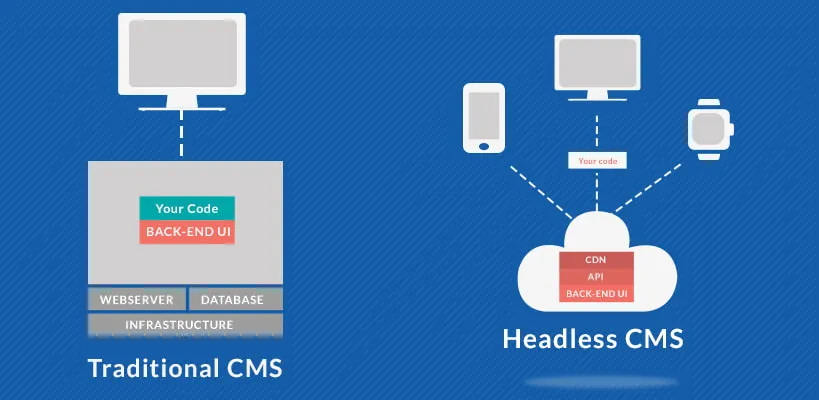



In this blog, I will try to cover every aspect of headless CMS so that you have complete information required to choose the perfect CMS system for your application.
So without further ado, let’s get started –
A headless CMS is nothing different from a traditional headless CMS. The only difference between the two is that the headless CMS lacks the display layer or the front-end user experience.
This gives the developers the flexibility to deliver content beyond websites and mobile applications such as smart watches, IoT devices, and even for Virtual Reality (VR) headsets.

The above figure clearly demonstrates the difference between headless CMS and traditional (decoupled) CMS systems.
Headless CMS offers the advantage of refreshing the design without changing the whole CMS system
Only one instance of headless CMS is required for display on any device either it is the website, mobile, tablets, IoT devices, etc.
Headless CMS offers centralized content management and the ability to distribute content in a universal format thereby allowing you to manage the entire platform from a single interface.
The web world has moved beyond websites. The users are increasingly moving towards mobile apps, virtual reality, augmented reality, voice-controlled digital assistants, IoT devices and more. For the success of your business, you need to be present on each and every platform.
There is a need for a new CMS system that can handle omnichannel content management. Headless CMS uses an Application Programming Interface (API) which makes the content available on any device and any platform.
The digital transformation is taking place at a very fast pace. For your business to stay ahead, you need to give your users new digital experiences at a very fast pace. So you need to be more agile and test new ideas in days, not months.
Headless CMS works on Software as a Service model in a true sense thereby offering you the ability to deploy applications faster.
Headless CMS offers the next-generation content management that enables brands to engage their customers in the growing number of channels.
We are living in a multichannel world comprising of desktops, laptops, mobile devices, tablets, smart watches, health bands, IoT devices, smart televisions, smart speakers, voice-assistants, and many more.
Here are some interesting facts which you must know –
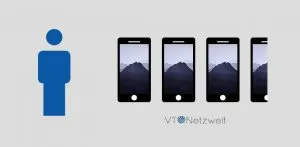

For many years, we have been focusing on the traditional CMS systems which were more web-oriented. Here are the 4 main trends which paved the path for headless CMS –
As explained earlier, we are living in a multi-channel world. You don’t know as which device is being used by the user to consume content.
So if you don’t want to lose your customers, you need to make sure that your content is present on multiple platforms and channels.
A new system is required which can structure and manage content on multiple platforms. Although the traditional CMS offers structured content but the new paradigm is way out of line for them.
Change is inevitable. To survive in the rapidly changing world, companies need to embrace digital transformation as part of their core strategy.
This digital transformation as forced even bigger organizations to act like a startup and quickly test new ideas and deploy them for their users.
The traditional CMS systems were designed for traditional business processes and cannot withstand the changing digital economy.
Microservices approach represents one of the major shift in software architecture.
The earlier systems were built on monolithic architecture. So if the company decided to change the CMS, they had to start from scratch.
The new generation CMS system follows API first or headless approach which makes it easy to be integrated into any application without the worry of the technology stack.
Today, every company is moving to the cloud. They have realized that running any system internally lacks flexibility, speed and is less efficient.
While the traditional CMS systems can be deployed on a cloud environment very easily but they are not true cloud solutions as they were not designed as Software as a Service product.
With headless CMS, you don’t need to worry about infrastructure anymore. You can free yourself from the worries of backups, database maintenance, server maintenance etc. You just need to manage your content and that’s all.
Headless CMS offers better security than the traditional CMS application. Although you need to make sure that your code is secure but still it is more feasible in headless CMS as any patch or fixes on the security flaw ensures that it is fixed for all your customers.
You can write your website or mobile application in any programming language using your own development process. Headless CMS offers you complete control over your application lifecycle.
You can go with traditional CMS if –
Creating a content hub for your organization
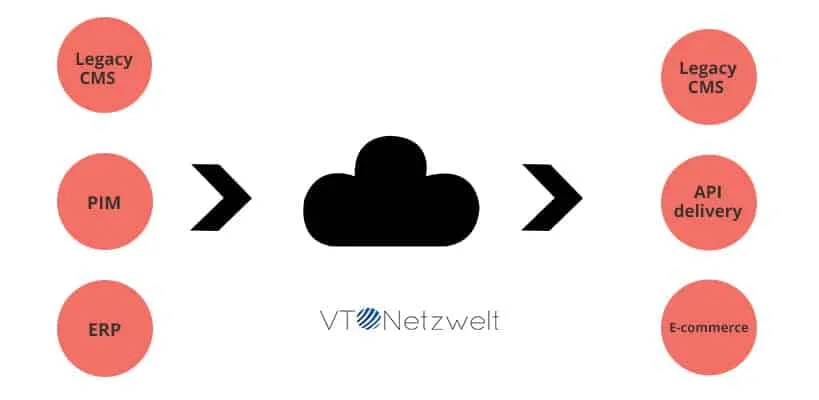
You can create a centralized content hub for your organization which will act as a master content management system. It will act as a single source of content for your whole organization.
With the central content management, you can avoid creating content at the departmental level which creates inconsistency.
You can import the whole content from various sources in the central repository where the employees can collaborate easily and you can also export it to your website or your custom enterprise application using API.
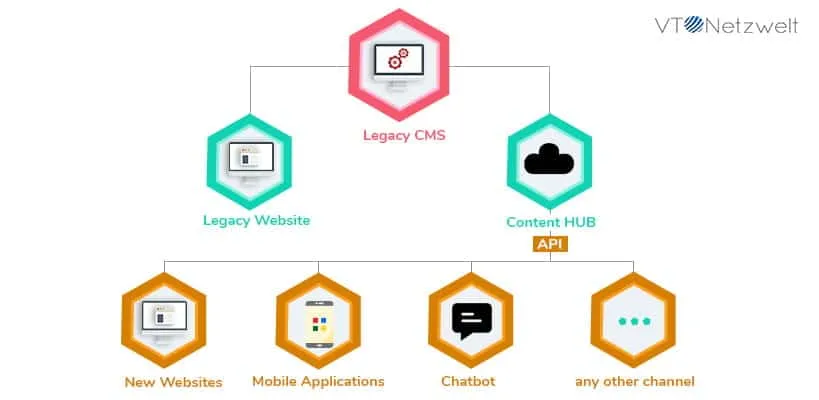
I understand that it is not an easy decision to replace a legacy CMS system if you have invested a good amount of money on it and already have a good number of user base.
In this particular scenario, you can use headless CMS as a proxy.
As it is very much clear from the figure above, you can export the whole content into the headless CMS and then use the API approach for multichannel.
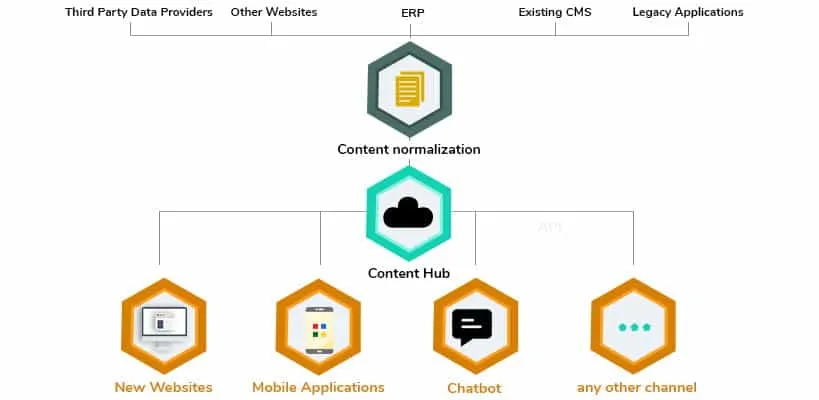
You may be having a system where you collect content from multiple applications such as ERP, legacy CMS, other websites, RSS feeds, etc.
In this case, you can easily collect the content from multiple sources, change it to the required format and then use the headless CMS so that you can make it available across multiple channels and platforms.
Headless CMS is the future of content management and multichannel support.
Its API-first architecture offers agility and flexibility. Now it’s your choice.
Choose headless CMS and gain an upper edge over your competitor. Request a call back from our industry experts.
A headless CMS is a content management system that focuses solely on content creation and storage, without dictating how content is presented or delivered. It provides a backend interface for content management, while developers use APIs to fetch and display content dynamically on various platforms, such as websites, mobile apps, and IoT devices. This decoupled architecture allows for greater flexibility, scalability, and customization in delivering content across different channels and devices.
Headless CMS offers flexibility by decoupling content management from frontend presentation, enabling seamless content delivery across various platforms via APIs. It empowers developers to innovate and adapt to evolving digital trends while ensuring consistent content experiences. Additionally, headless CMS facilitates faster development cycles and easier scalability, making it ideal for businesses aiming to deliver dynamic and engaging content across multiple channels.
When considering a CMS solution, it’s essential to assess your project requirements and goals. If you value flexibility, scalability, and the ability to deliver content seamlessly across diverse platforms and devices, a headless CMS may be the right choice. However, if you prioritize a tightly integrated content management and presentation layer with predefined templates and themes, a traditional CMS may better suit your needs. Evaluating factors like development resources, content strategy, and long-term scalability will help determine the best option for your project.
The need for headless CMS arose from the demand for more flexible and scalable content delivery solutions. With the proliferation of diverse digital channels and devices, businesses required a CMS that could seamlessly deliver content across various platforms without being tied to specific frontend technologies. Headless CMS addresses this need by decoupling the content management backend from the frontend presentation layer, allowing for greater agility, customization, and future-proofing of digital experiences.
The need for headless CMS arises from the demand for flexible, scalable, and omnichannel content delivery. By decoupling the content management backend from the frontend presentation layer, headless CMS systems enable developers to deliver content dynamically across diverse platforms and devices through APIs. This approach allows for greater agility, customization, and future-proofing of digital experiences in a rapidly evolving digital landscape.
Headless CMS systems differ from traditional CMS systems in their architecture and content delivery approach. While traditional CMS systems tightly couple the content management backend with the frontend presentation layer, headless CMS systems follow a decoupled architecture, separating these components. This allows for greater flexibility and scalability, as developers can use APIs to fetch and display content dynamically on various platforms, including websites, mobile apps, and IoT devices.
Are You Prepared for Digital Transformation?
Web Development Blog
Test Driven Development (TDD) is a programming practice which enables developers to write code only if an automated test has failed thereby avoiding duplication of the code.
Web Development Blog
Vue.js is a progressive JavaScript framework that is used to build the user interface of modern applications without using a lot of resources. Vue.js mainly focus on the view layer, which enables developers to integrate it into the existing projects without any hassle. Vue.js is a perfect choice for building single-page applications (SPA).
Web Development Blog
If you are a developer working in a team, then you must realize how difficult and frustrating it becomes when it comes to file sharing. No matter how hard you try for effective collaboration within the team but the fact is that the things become chaotic when there is no version control system.